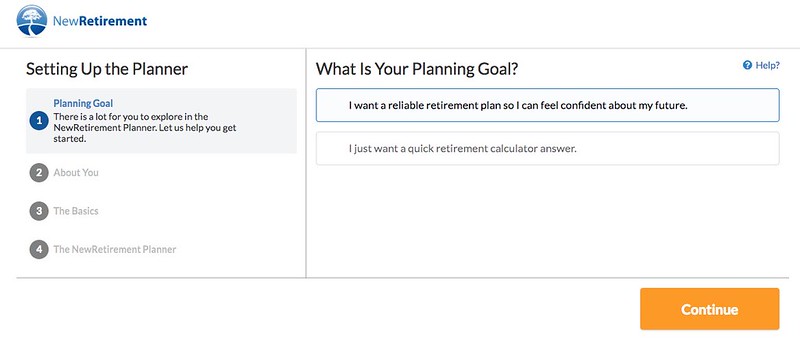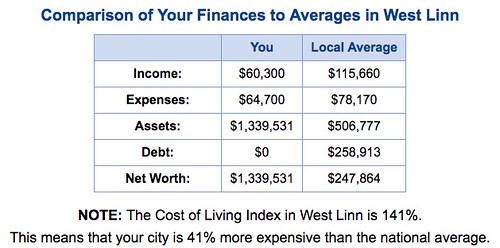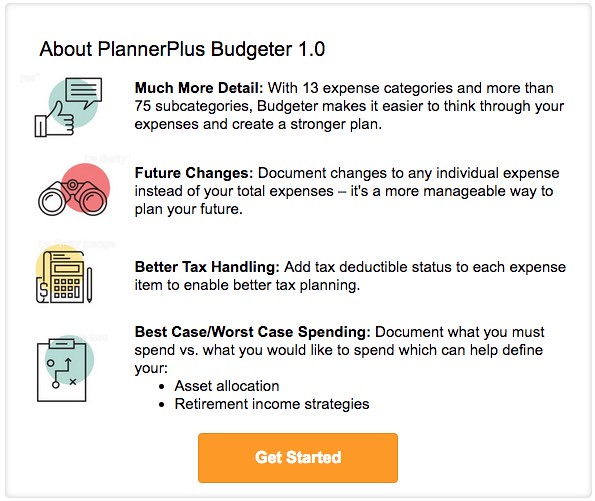In a recent article in The Atlantic, Joe Pinsker shared some thoughts on why many ultrarich people aren't satisfied with their wealth.
There seem to be two reasons.
- First, people tend to ask themselves: Am I doing better than I was before? Do I have more today than I did yesterday? “All the way up the income-wealth spectrum,” one researcher told Pinsker, “basically everyone says [they'd need] two or three times as much” to be perfectly happy. It's the hedonic treadmill in action.
- Second, people can't help but compare themselves to others. They ask themselves: Do I have as much (or more) than the people I'm comparing myself with? Do I have more than other folks in my family? Do I have more than my friends? Do I have more than my co-workers? We measure our personal success by comparing what we have to what other people have. This is the proverbial “keeping up with the Joneses“.
While Pinsker's article is about the ultrarich, I think these tendencies apply to nearly everyone. Even me.
People in the middle class are just as inclined to hop on the hedonic treadmill. They're just as likely to compare what they have to what their friends have. The same goes for those who aren't well off. Even people in poverty get sucked into the comparison game.
In fact, I'd argue that for the poor and middle class, there's an added element. Time and again, statistics show that folks with lower incomes watch tons more TV than people who earn more. (Also here — and many more studies.) When you allow yourself to succumb to the “other world” of film and TV, you're exposed to more ideas about how people should and do live — even if these ideas are baseless. (It's like “The Grand Illusion” by Styx: “Don't be fooled by the radio, the TV, or the magazines. They show you photographs of how your life should be, but they're just someone else's fantasy.”)
The rich compare themselves to themselves and others. The poor do too but they also compare themselves to fictional characters on film and television.
The bottom line seems to be that comparing your situation to anyone is likely to lead to trouble. Whether you're comparing yourself to yourself, your family, your friends, or to people in Hollywood productions, doing so leads to a desire for more.
But it doesn't have to be this way.
Non-Consumer Advocates
Over the past few years, the early retirement movement has risen to prominence. People have figured out that they don't have to work for forty or fifty years at jobs they hate. If they manage to increase the gap between their earning and spending — if they can maintain a high saving rate — then then they can achieve financial independence at age fifty. Or forty. Or thirty-five.
Boosting income is a very important part of this equation, of course, but it's not the only piece of the puzzle. The fundamental equation of personal finance is this: Your wealth equals what you earn minus what you spend. Your spending plays a crucial role in how quickly you're able to build wealth and/or achieve your financial goals.
If you want to spend less, it's vital you resist the urge to compare yourself to others.
This is one of the FIRE movement's greatest virtues. From my experience, the folks in the early retirement community have consciously opted out of the comparison game. Thanks largely to the work of Joe Dominguez and Vicki Robin (authors of the classic Your Money or Your Life), financial independence is frequently framed as a life of non-consumption.
Here are some sample quotes from Dominguez and Robin:
- “If you live for having it all, what you have is never enough.”
- “How you spend your money is how you vote on what exists in the world.”
- “Americans used to be ‘citizens'. Now we are ‘consumers'.”
- “Consumption seems to be our favorite high, our nationally sanctioned addiction, the all-American form of substance abuse.”
- “Frugality is enjoying the virtue of getting good value for every minute of your life energy and from everything you have the use of.”
Dominguez and Robin helped to found the financial independence movement, and they founded it as non-consumer advocates. It helps too that Mr. Money Mustache, who has helped popularize FIRE in recent years, is also a non-consumer advocate. He's written extensively about topics like hopping off the hedonic treadmill and the virtues of frugality.
Obviously, not everyone interested in early retirement wants to be thrifty. Some people want to achieve financial indendence in order to pursue lives that cost money. They want fancy houses and fancy cars. They do want to have more than the folks around them. And that's fine.
Most of us, however, have come to realize that this fancy shit won't make us happy.
Note: While it's great that there's no pressure to spend in FI circles, I don't want to pretend that it's without competition. In fact, there's a sort of perverse opposite pressure. Too many people want to participate in frugal shaming and financial one-upmanship, racing to see who can spend the least. This sort of bragging is just as unhealthy as competitive spending and I wish that it would stop. But at least competitive frugality helps your finances instead of hurting them.
The Virtue of Frugality
While the non-consumer core of the FIRE movement naturally leads followers toward frugality, frugality has very real financial benefits regardless whether you care about consumption.
- The less you consume, the less you have to earn to support your lifestyle.
- The less you consume, the less baggage you have in your life.
- The less you consume, the sooner you can retire.
Like me, you've probably seen this math a million times. But I hope that, like me, you never tire of its beauty.
Let's say you have an average job. Maybe you're a box salesman (or saleswoman). You earn $50,000 per year selling corrugated packaging to industrial clients in your hometown. If you earn $50,000 per year and you spend $50,000 per year, you have no “margin”. If something goes wrong — you get sick, you lose your job — you have no choice but to cut back because your living expenses are the same as your income.
If, on the other hand, you spend only $25,000 per year, you have a buffer. If you suffer some sort of catastrophic box injury that prevents you from working for six months, you'll be better able to cope with the crisis. If you lose your job, you only have to find a job that pays $25,000 instead of a job that pays $50,000. By spending less, you give yourself more options for work.
The less you consume, the less you have to earn to support your current lifestyle. And the less you consume, the sooner you can retire in the future.
By maintaining an ambitious saving rate of 50 or even 70 percent in your twenties and thirties, you can retire when you're 40 years old instead of 65. This gives you forty years of freedom to do what you want with life rather than fifteen.
This table demonstrates the power of profit margin, the power of frugality:
![This table is the single most powerful argument I know to save as much money as you can. [The Power of Profit Margin]](https://farm2.staticflickr.com/1606/24677814599_a2ee8d5d77_z.jpg)
Spending less makes all financial goals easier to achieve. As Dave wrote in his guest post earlier this week, frugality buys discipline — and discipline equals freedom.
Depriving yourself of certain “standard” choices now means you don't have to lead a life of deprivation when you're older. When you choose to spend less, you're not just boosting your bottom line. You're also gaining the time and freedom that would have been required to earn that money. Thrift isn't deprivation. It's wealth.
(This reminds me of Dave Ramsey's famous quote: “If you will live like no one else, later you can live like no one else.”)
Frugality and Me
So, why am I writing about this? Why have I been thinking so much about frugality lately? After all, I'm hardly a poster boy for thrift. I am by nature a spender. This is a known issue and has been all of my life.
That said, I do aspire to frugality. I admire frugal people. Because frugality is a core value of the early retirement movement, and because I spend much of my time with the FIRE crowd, their inclination toward frugality tends to act as a brake on my own spending. This is a good thing. And because many of my colleagues are non-consumer advocates, I find myself thinking about frugal alternatives (even if I don't always follow through with them).
This year, in particular, I've been focused on spending less. After writing about my plans for 2019 earlier this month, I've done my best to get back to basics. Here are some examples:
- Kim and I are both actively trying to spend less on food. So far, we're succeeding. (Minor victory: We both wanted to eat out at our favorite bar last week. Instead, she picked up a $5 frozen pizza on her way home from work. That probably saved us forty bucks!)
- Both of our cars are beginning to show their age. Kim's 1997 Honda Accord has never had any major issues, but currently has a variety of minor mechanical problems. My 2004 Mini Cooper has had two major repairs in the past two years. Right now, the sunroof is leaking, which isn't good during a rainy Oregon winter. We've talked about buying a new vehicle. (And we still might.) For now, however, I bought a 1993 Toyota pickup for $1900. We've become a three-car household — but those three vehicles have an average age of 21 years and an average value of $1500.
- After spending so much on home repairs during our first eighteen months in this house, we've been diving deep into DIY mode. This month, Kim has been painting the bedrooms. I'm repairing fences and faucets. There's still plenty that needs to be done around here, but we're going to take our time and learn how to do much of it ourselves.
- We're both out of shape and we know it. Our gym contracts have some time left on them, so we'll keep going for a while. Meanwhile, we've begun to set ourselves up for success here at home. We re-arranged the family room so that it's yoga-friendly. I set up an indoor bike trainer so that I have no excuse for not pedaling thirty minutes per day. We've both decided to reduce our alcohol intake.
- We've stopped thinking “new” and started thinking “used”. Twice this month, I've shopped at local thrift stores instead of defaulting to Amazon. I recently traded some concert tickets to my ex-wife for my old Nintendo Wii. We've been giving our used clothes and dishes to friends. Instead of meeting friends in restaurants for dinner, we're planning to meet at each other's homes. (How old fashioned!)
Frugality may not a natural thing for me but I can do it. Plus, it's fun. It's fun for me to challenge myself, to look at how and why I engage in consumer behavior — then to think about ways I can “opt out”.
As I mentioned at the start of this article, even the ultrarich compare themselves to others (and to their past selves). I'm just as guilty as anyone else. I always want more. Nothing is ever enough for me. I'm not sure why this is the case but it is. It's a reality that I have to deal with.
It's because of this constant craving that it's so important for me to spend time with my friends in the early retirement community. They apply peer pressure, but it's positive peer pressure. I see the frugal choices they make and I want to make similar choices. I hear how they get by with less and I want to get by with less.
“As you take your eyes off the false prize (of more, better, and different stuff), you put them on the real prizes: friends, family, sharing, caring, learning, meeting challenges, intimacy, rest, and being present, connected, and respected. In other words, those best things in life that are free.” — Joe Dominguez and Vicki Robin, Your Money or Your Life
The post Why frugality is an important part of personal finance appeared first on Get Rich Slowly.
from Get Rich Slowly http://bit.ly/2MIALQN







































